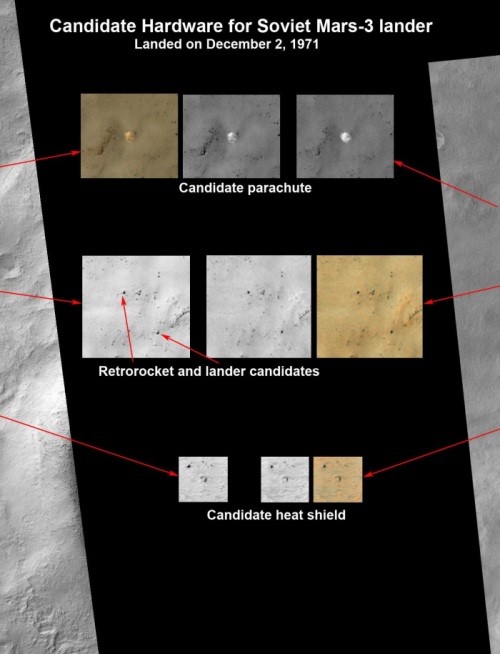
The image above shows possible hardware left over from the Soviet Union’s Mars 3 lander, which touched down on the Red Planet in 1971 but was only able to transmit 14.5 seconds worth of data before losing contact with Earth.
The discovery of the left-behind equipment was made not by NASA, but rather a web-based group of Russian space enthusiasts. They were studying a five-year-old image taken of an area on Mars where it was believed the lander went down, whereupon they spotted what they believed were the craft’s parachute, heat shield, terminal retrorocket, and lander. They requested an updated image from NASA, got it, compared the two images, and confirmed their findings.
Sound like a bunch of hodgepodge? Well, NASA reviewed their work and actually confirmed that the group is onto something.
They released a report detailing how this story came about:
It was estimated that the landing site for the Lander was at latitude 45 degrees south, longitude 202 degrees east, in Mars’ Ptolemaeus Crater. HiRISE acquired a large image at this location in November 2007, but because the image contained 1.8 billion pixels of data, about 2,500 typical computer screens would be needed to view the entire image at full resolution. The software required to take on a project like this didn’t become available until only recently.
Space enthusiasts in a Russian-based Internet community got together and crowd-sourced a project to do some preliminary searching of the HiRISE photo for the Mars 3 lander. The leader of the group, Vitali Egorov, modeled what Mars 3 hardware pieces should look like in a HiRISE image, and the group worked together to carefully search all of the small features of this very large image, finding what appear to be reasonable candidates in the southern part of the image.
Each candidate had a size and shape consistent with the expected hardware, and they were all arranged on the surface in a manner consistent with the entry, descent, and landing sequence of the Mars 3 lander.
An advisor to the group, Alexander Basilevsky, contacted Alfred McEwen, principal investigator for HiRISE, and suggested that McEwen’s team take a follow-up image on the area.
HiRISE acquired this follow-up image on March 10, 2013.
The image itself was specially targeted to cover some of the hardware candidates in color and to get a second look with different illumination angles. While HiRISE was getting the new image, Basilevsky and Egorov contacted Russian engineers and scientists who worked on Mars 3 for more information on the lander and the components they were looking for.

Close-up of the comparison between the two photos.
The most distinct and unusual feature in the image is what could possibly be the parachute. It’s an especially bright spot for the region and about 8.2 yards in diameter. The parachute would have a diameter of 12 yards if fully spread out over the surface so, all things considered, the finding is fairly consistent with the original piece of equipment.
If you look really close at the second HiRISE image, the parachute looks like it brightened over much of its surface over the years. The brightening is probably due to better illumination over the sloping surface, but it is also possible that dust was removed over the years, which resulted in a brightening of the area.
The retrorocket was attached to the lander container by a chain, and the suggested feature in the photo has the right size and even shows a linear extension which could possibly be the chain.
Nearby is a feature with the right size and shape to be the actual lander, with what appears to be four open petals.
The image of the possible heat shield, meanwhile, matches a shield-shaped object with the right size (if partly buried).
Together, this set of features and their layout on the ground provide an incredible match to what is expected from the Mars 3 landing — but it’s not a slam dunk case yet. Further analysis of the data and future images are needed in order to better understand the shapes. Only then can we (and by “we” I mean NASA) actually confirm or deny these findings.
Story via: nasa.gov
Advertisement
Learn more about Electronic Products Magazine





